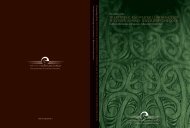2007 Annual Report - NgÄ Pae o te MÄramatanga
2007 Annual Report - NgÄ Pae o te MÄramatanga
2007 Annual Report - NgÄ Pae o te MÄramatanga
You also want an ePaper? Increase the reach of your titles
YUMPU automatically turns print PDFs into web optimized ePapers that Google loves.
case study 11<br />
• Completion of scoping projects<br />
on Mäori migration overseas<br />
by Manuhuia Barcham (Ngäti<br />
Kahungunu, Te Arawa, Ngäti<br />
Tüwharetoa); and on researching<br />
a methodology for defining iwi<br />
boundaries by Drs Cheryl Smith<br />
(Ngäti Apa) and Paul Reynolds (Ngäti<br />
Tüwharetoa, Ngä Puhi) from Te<br />
Atawhai O Te Ao: Independent Mäori<br />
Institu<strong>te</strong> for Environment and Health.<br />
• A study by Dr Philip Lyver (Ngäti<br />
Toarangatira/Ngäi Tahu), of Manaaki<br />
Whenua Landcare Research, who<br />
is collaborating with kaumätua and<br />
representatives from Hauraki to<br />
in<strong>te</strong>gra<strong>te</strong> mätauranga (traditional<br />
knowledge) with a wider project<br />
on the sustainability of oi<br />
(grey-faced petrels or northern<br />
muttonbird) harvests on the<br />
Ruamaahua Islands. This study is<br />
an excellent example of research<br />
being led by mätauranga Mäori.<br />
As no<strong>te</strong>d elsewhere in this report, in <strong>2007</strong><br />
we also reviewed stra<strong>te</strong>gies to support<br />
advancement for mid-career and senior<br />
Mäori researchers. This was assis<strong>te</strong>d<br />
by ex<strong>te</strong>rnal review and appraisal from<br />
the In<strong>te</strong>rnational Research Advisory<br />
Panel who confirmed strong support<br />
for Ngä <strong>Pae</strong> o <strong>te</strong> Märamatanga research<br />
results and processes. The Panel will<br />
continue to contribu<strong>te</strong> to the evaluation<br />
of investment in the research programme<br />
to seek the most effective outcomes.<br />
We welcomed their endorsement, which<br />
capped a strong year and confirmed<br />
a firm foundation for the future.<br />
Homing in on Animal Navigation How do birds naviga<strong>te</strong> vast oceans,<br />
correcting themselves when blown off-course The inner compass possessed<br />
by some animals is an enigma that has absorbed Professor Michael Walker,<br />
Joint Director of Ngä <strong>Pae</strong> o <strong>te</strong> Märamatanga, for many years. His breakthrough<br />
in extracting magneti<strong>te</strong> – the iron mineral also known as lodestone – from<br />
yellowfin tuna established a physical basis for this creature’s ability to de<strong>te</strong>ct<br />
the Earth’s magnetic field and was published in Science magazine in 1984. And,<br />
in November <strong>2007</strong>, Science again gave ex<strong>te</strong>nsive coverage to Michael’s work,<br />
saying his further research looked close to finally clinching magneti<strong>te</strong>’s crucial<br />
role in animal navigation.<br />
The mineral had already been found in birds, but research recently comple<strong>te</strong>d<br />
by a <strong>te</strong>am led by Dr Todd Dennis, Matt Rayner and Michael, in a collaboration<br />
between the School of Biological Sciences at the University of Auckland and<br />
Ngä <strong>Pae</strong> o <strong>te</strong> Märamatanga, demonstra<strong>te</strong>s pigeons almost certainly use the<br />
magneti<strong>te</strong> in their natural global positioning sys<strong>te</strong>m.<br />
Geophysicist Joseph Kirschvink of the California Institu<strong>te</strong> of Technology, who is<br />
himself one of the pioneers of research into magneti<strong>te</strong>, told Science:<br />
“If there is ever a Nobel Prize for magnetic field perception,<br />
Walker‘s name will be on it.”<br />
From the Whakatöhea iwi, in the Bay of Plenty,<br />
Michael grew up aware of both European<br />
science and his Mäori grandmother’s use of the<br />
maramataka, the lunar sys<strong>te</strong>m for planting and<br />
fishing. A “hybrid mind,” he says, helped fos<strong>te</strong>r<br />
a fascination for different navigational methods<br />
– and an instinct, perhaps, for looking to nature<br />
for fresh clues on how things work.<br />
Finding the secrets of animal GPS:<br />
Professor Michael Walker<br />
The Virginian Originally hailing from the sta<strong>te</strong> of Virginia, Dr Todd Dennis<br />
landed in the Ureweras to see if New Zealand can find a bet<strong>te</strong>r way to manage<br />
possums. Using advanced micro-GPS <strong>te</strong>chnology<br />
to pinpoint possum movements near the rural<br />
community of Ruatähuna, Todd is also aiming<br />
to help a local industry. “Precise tracking using<br />
sa<strong>te</strong>lli<strong>te</strong> <strong>te</strong>lemetry can help us bet<strong>te</strong>r understand<br />
the movement pat<strong>te</strong>rns of introduced pests,<br />
and may well suggest the most effective control<br />
measures for different situations – all while<br />
helping to develop a possum-fur industry that is<br />
important to the local economy,” he says.<br />
Dr Todd Dennis: Research Fellow,<br />
Ngä <strong>Pae</strong> o <strong>te</strong> Märamatanga
















